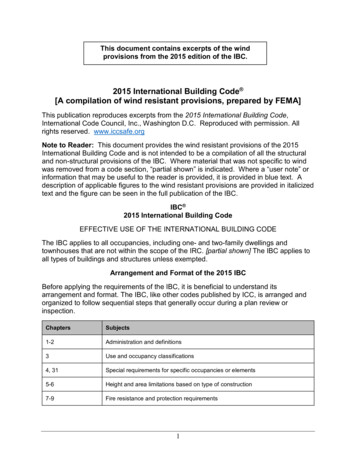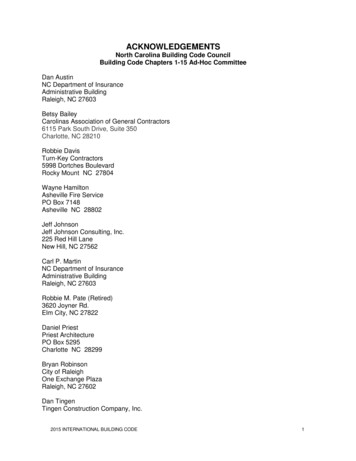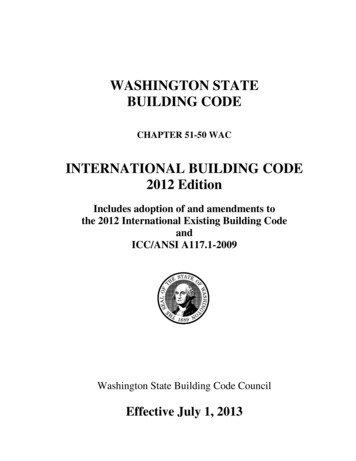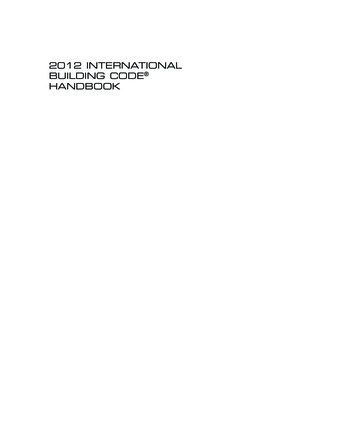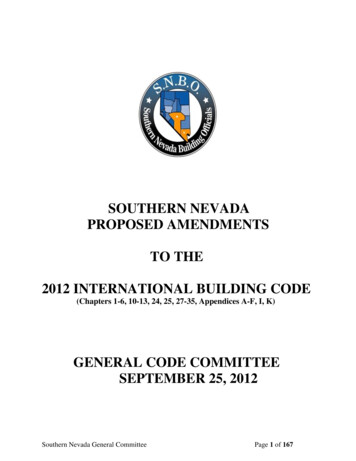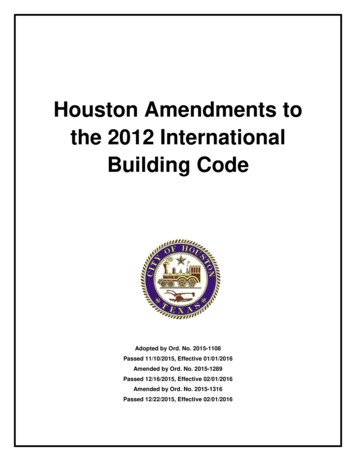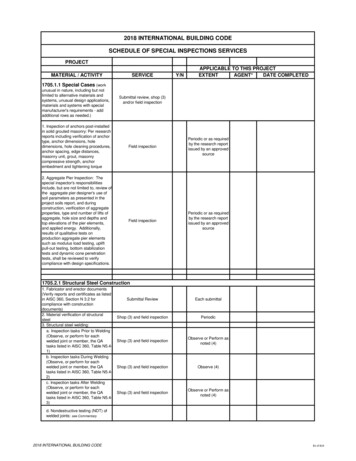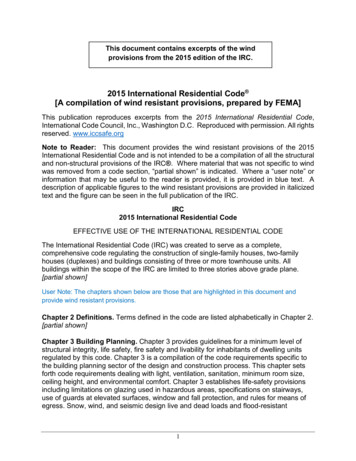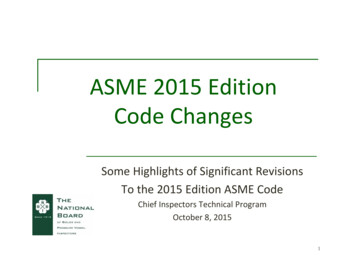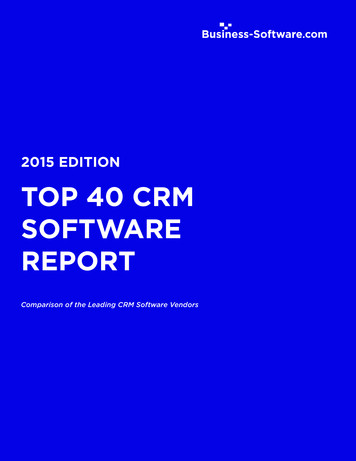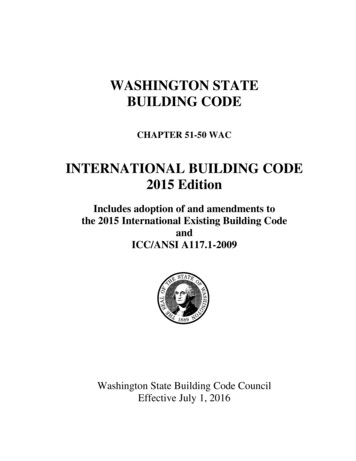
Transcription
WASHINGTON STATEBUILDING CODECHAPTER 51-50 WACINTERNATIONAL BUILDING CODE2015 EditionIncludes adoption of and amendments tothe 2015 International Existing Building CodeandICC/ANSI A117.1-2009Washington State Building Code CouncilEffective July 1, 2016
Copies of the State Building Codes andcomplete copies of the 2015 International Building Codeas published by the International Code Councilmay be obtained from:Washington Association of Building OfficialsPost Office Box 7310Olympia, Washington 98507-7310(360) 628-8669www.wabobookstore.orgor toll free in Washington State at (888) 664-9515The 2015 International BuildingCode,as published by the International Code Council,may be viewed at the following /I-Codes/2015%20IBC%20HTML/index.htmlFirst Edition TitledInternational Building CodeChapter 51-50 WACbased onWSR 16-03-069Effective July 1, 2016
PrefaceAuthority: The International Building Code (Chapter 51-50 WAC) is adopted by the Washington State Building Code Councilpursuant to Chapters 19.27 and 70.92 RCW. These codes were first adopted by reference by the Washington State Legislature in1974. In 1985, the Legislature delegated the responsibility of adoption and amendment of these codes to the State Building CodeCouncil.Code Precedence: The State Building Code Act, Chapter 19.27 RCW, establishes the following order of precedence among thedocuments adopted as parts of the State Building Code:International Building Code, Standards and amendments -WAC 51-50;International Residential Code, Standards and amendments – WAC 51-51;International Mechanical Code, Standards and amendments - WAC 51-52;International Fire Code, Standards and amendments - WAC 51-54A;Uniform Plumbing Code, Standards and amendments - WAC 51-56Where there is a conflict between codes, an earlier named code takes precedence over a later named code. In the case of conflictbetween the duct insulation requirements of the International Mechanical Code and the duct insulation requirements of theEnergy Code, the Energy Code, or where applicable, a local jurisdiction's energy code, shall govern.Where, in any specific case, different sections of this Code specify different materials, methods of construction or otherrequirements, the most restrictive shall govern. Where there is conflict between a general requirement and a specific requirement,the specific requirement shall be applicable.Organization and Numbering: These rules are written to allow compatible use with the International Building Code. Allsections which are amended, deleted, or added are referenced.Enforcement: The State Building Code Act requires that each local jurisdiction enforce the State Building Code within itsjurisdiction. Any jurisdiction can contract with another jurisdiction or an inspection agency to provide the mandated enforcementactivities.Amendments to the State Building Code:The State Building Code Council has adopted review procedures and approval criteria for local amendments. Theseprocedures and criteria are found in Chapter 51-04 WAC. The Council has exempted from its review any amendmentsto the administrative provisions of the various codes.Forms for proposing statewide amendments to the State Building Code are available from the State Building CodeCouncil staff.A. Amendments of Statewide Application: On a yearly basis the State Building Code Council will considerproposals to amend the State Building Code. Unless directed by the State Legislature, federal mandates or courtorder, the Council will not enter formal rulemaking until 2018 as part of its consideration of adoption of the 2018series of codes.Proposals to amend the State Building Code shall be made on forms provided by the Building Code Council.Code Change Proposal Submittal Deadline: March 1st of each year.B. Local Amendments: Any jurisdiction may amend the State Building Code provided the amendments do not reducethe minimum performance standards of the codes. There are areas where local amendments are limited orprohibited:i
Prohibited Amendments: Residential provisions of the State Energy Code (WAC 51-11R and WAC 51-11C),Ventilation provisions in Section 408 of the Mechanical Code (WAC 51-52) and Section M1507 of the IRC (WAC 5151); any provision of the International Building Code or International Residential Code affecting accessibility; andstandards specifically adopted in Chapters 19.27 and 19.27A RCW cannot be amended by any local jurisdiction.Residential Amendments: Amendments by local jurisdictions which affect the construction of single familyand multi-family residential buildings must be reviewed and approved by the State Building Code Councilbefore such amendments can be enforced. The State Building Code Act provides the following definition:“Multi-family residential building” means common wall residential buildings that consist of fouror fewer units, that do not exceed two stories in height, that are less than 5,000 square feet in area,and that have a one-hour fire-resistive occupancy separation between units.Application forms for Council review of local amendments are available from the State Building Code Council Staff.Washington State Building Code CouncilPost Office Box 41449Olympia, Washington 98504-1449www.sbcc.wa.gov(360) 407-9280Fax (360) 586-5366e-mail: sbcc@des.wa.govPrinting Format: This version of the rules is published as a series of insert or replacement pages. Each page providesinstructions for installing them in the model code book. Amendments to the model code which are new or revised fromthe previous edition of this code are indicated by a line in the margin next to the revised portions.Effective Date: These rules were adopted by the State Building Code Council on November 13, 2015. The rules areeffective throughout the state on July 1, 2016. (This version of the code is based on WAC 51-50 as published inWSR 16-03-069.Building Permit Fees: The activities of the State Building Code Council are supported by permit fees collected by eachcity and county. Section 19.27.085 of the State Building Code Act requires that a fee of 4.50 be imposed on eachbuilding permit issued by each city and county. In addition, a fee of 2.00 per unit shall be imposed for each dwellingunit after the first unit, on each building containing more than one residential unit. For the purpose of this fee, WAC 5105 defines building permits as any permit to construct, enlarge, alter, repair, move, improve, remove, convert ordemolish any building or structure regulated by the Building Code. Exempt from the fee are plumbing, electrical,mechanical permits, permits issued to install a mobile/manufactured home, commercial coach or factory built structure,or permits issued pursuant to the International Fire Code.Each city and county shall remit moneys collected to the state treasury quarterly. No remittance is required until aminimum of 50.00 has accumulated.These permit fees are the amounts current in January 2016. Such fees may be changed by the State Legislature.Opinions: Only at the request of a local enforcement official, the State Building Code Council may issueinterpretations/opinions of those provisions of the State Building Code created by the Council, or provisions of the modelcodes amended by the Council. Final interpretation authority for any specific permit resides with the local enforcementofficial.ii
Table of ContentsSectionWAC 51-50-001WAC 51-50-002WAC 51-50-003WAC 51-50-005WAC 51-50-007WAC 51-50-008WAC 51-50-009PageAuthority . APurpose . AInternational Building Code . AInternational Building Code Regulations for Barrier-free Accessibility . AExceptions . AImplementation . ARecyclable Materials, Compost and Solid Waste Storage . AChapter 1 AdministrationSection 108 – Temporary Structures and uses . 7Chapter 2 DefinitionsSection 202 – Definitions . 11Chapter 3 Use and Occupancy ClassificationSection 305 – Educational Group E .Section 306 – Factory Group F .Section 308 – Institutional Group I .Section 310 – Residential Group R .Section 312 – Utility and miscellaneous Group U .4243484951Chapter 4 Special Detailed Requirements Based on Use and OccupancySection 403 – High-Rise Buildings .Section 412 – Aircraft Related Occupancies.Section 420 – Groups I-1, R-1, R-2, R-3 .Section 422 – Ambulatory Care Facilities .Section 427 – Electric Vehicle Charging Infrastructure .6077939395Chapter 5 General Building Heights and AreasSection 503 – General Building Height and Area Limitations . 97Section 504 – Building Height and Number of Stories . 98Section 505 – Mezzanines and Equipment Platforms . 100Section 509 – Incidental Uses . 109Section 510 – Special Provisions . 110Chapter 7 Fire and Smoke Protection FeaturesSection 706 – Fire Walls . 124Section 716 – Opening Protectives . 142Chapter 9 Special Detailed Requirements Based on Use and OccupancySection 903 – Automatic Sprinkler Systems .Section 907 – Fire Alarms and Detection Systems .Section 909 – Smoke Control Systems .Section 915 – Carbon Monoxide Detection .211224243247Chapter 10 Means of EgressSection 1004 – Occupant Load . 251Section 1006 – Number of Exits and Exit Access Doorways . 255Section 1009 – Accessible Means of Egress . 257iii
Section 1010 – Doors, Gates and Turnstiles . 264Section 1011 – Stairways . 271Section 1012 – Ramps . 271Section 1020 – Corridors . 279Section 1028 – Exit Discharge . 286Chapter 11 AccessibilitySection 1101 – General . 295Section 1106 – Parking and Passenger Loading Facilities . 298Section 1107 – Dwelling Units and Sleeping Units . 300Chapter 12 Interior EnvironmentSection 1203 – Ventilation . 311Section 1204 – Temperature Control . 313Section 1208 – Interior Space Dimensions . 315Chapter 14 Exterior WallsSection 1403 – Performance Requirements . 319Chapter 16 Structural DesignTable 1607.1 – Minimum Uniformly Distributed Live Loads . 360Chapter 17 Structural Tests and Special InspectionsSection 1702 – Definitions. 403Section 1709 – Preconstruction Load Tests . 415Chapter 21 MasonrySection 2107 – Allowable Stress Design . 457Section 2111 – Masonry Fireplaces . 461Section 2114 – Emission Standards . 467Chapter 24 Glass and GlazingSection 2405 – Sloped Glazing and Skylights . 543Section 2407 – Glass in Handrails and Guards . 546Chapter 26 PlasticSection 2603 – Foam Plastic Insulation . 559Chapter 29 Minimum Plumbing Fixtures and Sanitation FacilitiesSection 2901 – General . 571Section 2902 – Minimum Plumbing Facilities . 571Chapter 30 Elevators and Conveying SystemsSection 3002 – Hoistway Enclosures . 575Section 3005 – Machine Rooms . 576Section 3009 – Hoistway Venting . 581Chapter 31 Special ConstructionSection 3103 – Temporary Structures . 584Section 3109 – Swimming Pool Enclosures and Safety Devices . 587Appendix N Solar ReadinessSection N101 – General . 662aiv
WAC 51-50-480000Washington State Amendments to the2015 International Existing Building CodeChapter 1 Scope and AdministrationSection 101 – General. 1Chapter 4 Prescriptive Compliance MethodSection 403 – Alterations .Section 407 – Change of occupancy.Section 409 – Moved Structures .Section 410—Accessibility for Existing Buildings .16202021Chapter 7 Alterations—Level 1Section 705 – Accessibility . 32Section 708 – Energy Conservation . 34Chapter 8 Alterations—Level 2Section 811 – Energy Conservation . 44Chapter 9 Alterations—Level 3Section 906 – Accessibility . 46Section 907 – Structural . 46Section 908 – Energy Conservation . 47Chapter 12 Historic BuildingsSection 1201 – General .Section 1203 – Fire Safety .Section 1204 – Alterations .Section 1205 – Change of Occupancy .59606061Chapter 13 Relocated or Moved BuildingsSection 1301 – General . 63v
BLANKvi
WASHINGTON STATE AMENDMENTSCHAPTER 51-50 WACSTATE BUILDING CODE ADOPTION AND AMENDMENTOF THE 2015 EDITION OF THE INTERNATIONAL BUILDING CODEWAC 51-50-001 AUTHORITYThese rules are adopted under the authority of Chapter19.27 RCW.WAC 51-50-002 PURPOSEThe purpose of these rules is to implement the provisionsof Chapter 19.27 RCW, which provides that the StateBuilding Code Council shall maintain the State BuildingCode in a status which is consistent with the purpose as setforth in RCW 19.27.020. In maintaining the codes theCouncil shall regularly review updated versions of thecodes adopted under the act, and other pertinentinformation, and shall amend the codes as deemedappropriate by the Council.WAC 51-50-003 INTERNATIONAL BUILDINGCODEThe 2015 edition of the International Building Code,including Appendix E, published by the International CodeCouncil is hereby adopted by reference with the exceptionsnoted in this chapter of the Washington AdministrativeCode.WAC 51-50-005 INTERNATIONAL BUILDINGCODE REQUIREMENTS FOR BARRIER-FREEACCESSIBILITYChapter 11 and other International Building Coderequirements for barrier-free access, including ICC A117.12009 and Appendix E, are adopted pursuant to Chapters70.92 and 19.27 RCW.Pursuant to RCW 19.27.040, Chapter 11 andrequirements affecting barrier-free access shall not beamended by local governments.WAC 51-50-007 EXCEPTIONSThe exceptions and amendments to the InternationalBuilding Code contained in the provisions of Chapter 19.27RCW shall apply in case of conflict with any of theprovisions of these rules.The provisions of this code do not apply to temporarygrowing structures used solely for the commercialproduction of horticultural plants including ornamentalplants, flowers, vegetables, and fruits. “Temporary growingstructure” means a structure that has the sides and roofcovered with polyethylene, polyvinyl, or similar flexiblesynthetic material and is used to provide plants with eitherfrost protection or increased heat retention. A temporarygrowing structure is not considered a building for purposesof this code.The provisions of this code do not apply to theconstruction, alteration, or repair of temporary workerhousing except as provided by rule adopted under chapter70.114A RCW or chapter 37, Laws of 1998 (SB 6168)."Temporary worker housing" means a place, area, or pieceof land where sleeping places or housing sites are providedby an employer for his or her employees or by anotherperson, including a temporary worker housing operator,who is providing such accommodations for employees, fortemporary, seasonal occupancy, and includes "labor camps"under RCW 70.54.110.Codes referenced which are not adopted through RCW19.27.031 or RCW 19.27A shall not apply unlessspecifically adopted by the authority having jurisdiction.The 2015 International Existing Buildings Code is includedin the adoption of this code in Section 101.4.7 and amendedin WAC 51-50-480000.WAC 51-50-008 IMPLEMENTATIONThe International Building Code adopted under Chapter51-50 WAC shall become effective in all counties and citiesof this state on July 1, 2016.WAC 51-50-009 RECYCLABLE MATERIALS,COMPOST, AND SOLID WASTE STORAGEFor the purposes of this section, the following definitionshall apply:COMPOSTmeans biodegradable solid wastes that areseparated for composting such as food waste, food soiledpaper and yard waste.RECYCLED MATERIALSmeans those solid wastes that areseparated for recycling or reuse, such as papers, metalsand glass.All local jurisdictions shall require that space be providedfor the storage of recycled materials, compost, and solidwaste for all new buildingsExceptions: Group R-3 and Group U occupancies.The storage area shall be designed to meet the needs ofthe occupancy, efficiency of pickup, and shall be availableto occupants and haulers.AEffective July 1, 2016
2015 INTERNATIONAL BUILDING CODEBLANKEffective July 1, 2016
WASHINGTON STATE AMENDMENTSBLANKEffective July 1, 2016
2015 INTERNATIONAL BUILDING CODE108.1 General. The building official is authorized to issue apermit for temporary structures and temporary uses. Suchpermits shall be limited as to time of service, but shall notbe permitted for more than 180 days. The building officialis authorized to grant extensions for demonstrated cause.Exception: The building official may authorize unheatedtents and yurts under 500 square feet accommodating anR-1 occupancy for recreational use as a temporarystructure and allow them to be used indefinitely.(Insert Facing Page 7)Effective July 1, 2016
WASHINGTON STATE AMENDMENTSBLANKEffective July 1, 2016
2015 INTERNATIONAL BUILDING CODEADULT FAMILY HOME.A dwelling, licensed by Washingtonstate, in which a person or persons provide personal care,special care, room and board to more than one but not morethan six adults who are not related by blood or marriage tothe person or persons providing the services.(Insert Facing Page 11)Effective July 1, 2016
WASHINGTON STATE AMENDMENTSASSISTED LIVING FACILITY.A home or other institution,licensed by the state of Washington, providing housing,basic services and assuming general responsibility for thesafety and well-being of residents under chapters 18.20RCW and 388-78A WAC. These facilities may providecare to residents with symptoms consistent with dementiarequiring additional security measures.(Insert Facing Page 12)Effective July 1, 2016
2015 INTERNATIONAL BUILDING CODEBOTTLE FILLING STATION.A plumbing fixture connectedto the potable water distribution system and sanitarydrainage system that is designed and intended for fillingpersonal use drinking water bottles or containers not lessthan 10 inches (254mm) in height. Such fixtures can beseparate from or integral to a drinking fountain and canincorporate a water filter and a cooling system for chillingthe drinking water.(Insert Facing Page 13)Effective July 1, 2016
WASHINGTON STATE AMENDMENTSCHILD CARE.The care of children during any period of a24-hour day.CHILD CARE, FAMILY HOME. A childcare facility, licensedby Washington state, located in the dwelling of the personor persons under whose direct care and supervision thechild is placed, for the care of twelve or fewer children,including children who reside at the home.(Insert Facing Page 14)Effective July 1, 2016
2015 INTERNATIONAL BUILDING CODECLIMATE ZONE.A geographical region that has beenassigned climatic criteria as specified in the WashingtonState Energy Code.CLUSTER.Clusters are multiple portable school classroomsseparated by less than the requirements of the building codefor separate buildings.(Insert Facing Page 15)Effective July 1, 2016
WASHINGTON STATE AMENDMENTSBLANKEffective July 1, 2016
2015 INTERNATIONAL BUILDING CODEEFFICIENCY DWELLING UNIT. A dwellingcontaining onlyone habitable room.(Insert Facing Page 19)Effective July 1, 2016
WASHINGTON STATE AMENDMENTSHOSPICE CARE CENTER.A building or portion thereof usedon a 24-hour basis for the provision of hospice services toterminally ill inpatients.(Insert Facing Page 26)Effective July 1, 2016
2015 INTERNATIONAL BUILDING CODEBLANKEffective July 1, 2016
WASHINGTON STATE AMENDMENTSBLANKEffective July 1, 2016
2015 INTERNATIONAL BUILDING CODENIGHTCLUB.An A-2 occupancy use under the 2006International Building Code in which the aggregate area ofconcentrated use of unfixed chairs and standing space thatis specifically designated and primarily used for dancing orviewing performers exceeds three hundred fifty square feet,excluding adjacent lobby areas. “Nightclub” does notinclude theaters with fixed seating, banquet halls, or lodgehalls.(Insert Facing Page 29)Effective July 1, 2016
WASHINGTON STATE AMENDMENTSBLANKEffective July 1, 2016
2015 INTERNATIONAL BUILDING CODEPORTABLE SCHOOL CLASSROOM.A prefabricated structureconsisting of one or more rooms with direct exterior egressfrom the classroom(s). The structure is transportable in oneor more sections and is designed to be used as aneducational space with or without a permanent foundation.The structure shall be capable of being demounted andrelocated to other locations as needs arise.(Insert Facing Page 31)Effective July 1, 2016
WASHINGTON STATE AMENDMENTSSMALL BUSINESS.Any business entity (including a soleproprietorship, corporation, partnership or other legalentity) which is owned and operated independently from allother businesses, which has the purpose of making a profit,and which has fifty or fewer employees.(Insert Facing Page 34)Effective July 1, 2016
2015 INTERNATIONAL BUILDING CODESTAGED EVACUATION.A method of emergency response,that engages building components and trained staff toprovide occupant safety during an emergency. Emergencyresponse involves moving or holding certain occupants attemporary locations for a brief period of time beforeevacuating the building. This response is used byambulatory surgery facilities and assisted living facilities toprotect the health and safety of fragile occupants andresidents.(Insert Facing Page 35)Effective July 1, 2016
WASHINGTON STATE AMENDMENTS305.2.4 Family home child care. Family home child carelicensed by Washington state for the care of twelve or fewerchildren shall be classified as Group R-3 or shall complywith the International Residential Code.306.2 Moderate-hazard factory industrial, Group F-1. (seenext page)(Insert Facing Page 42)Effective July 1, 2016
2015 INTERNATIONAL BUILDING CODE306.2 Moderate-hazard factory industrial, Group F-1. Factoryindustrial uses that are not classified as factory industrial F-2 lowhazard shall be classified as F-1 moderate hazard and shallinclude, but not be limited to, the following:Aircraft (manufacturing, not to include repair)AppliancesAthletic equipmentAutomobiles and other motor vehiclesBakeriesBeverages: Over 16 percent alcohol contentBicyclesBoatsBrooms or brushesBusiness machinesCameras and photo equipmentCanvas or similar fabricCarpets and rugs (includes cleaning)ClothingConstruction and agricultural machineryDisinfectantsDry cleaning and dyeingElectric generation plantsElectronicsEngines (including rebuilding)Food processing establishments and commercial kitchens notassociated with restaurants, cafeterias and similar dining facilitiesmore than 2,500 square feet (232m2) in areaFurnitureHemp productsJute productsLaundriesLeather productsMachineryMarijuana processingMetalsMillwork (sash and door)Motion pictures and television filming (without spectators)Musical instrumentsOptical goodsPaper mills or productsPhotographic filmPlastic productsPrinting or publishingRe
complete copies of the 2015 International Building Code as published by the International Code Council may be obtained from: Washington Association of Building Officials Post Office Box 7310 Olympia, Washington 98507-7310 (360) 628-8669 www.wabobookstore.o
